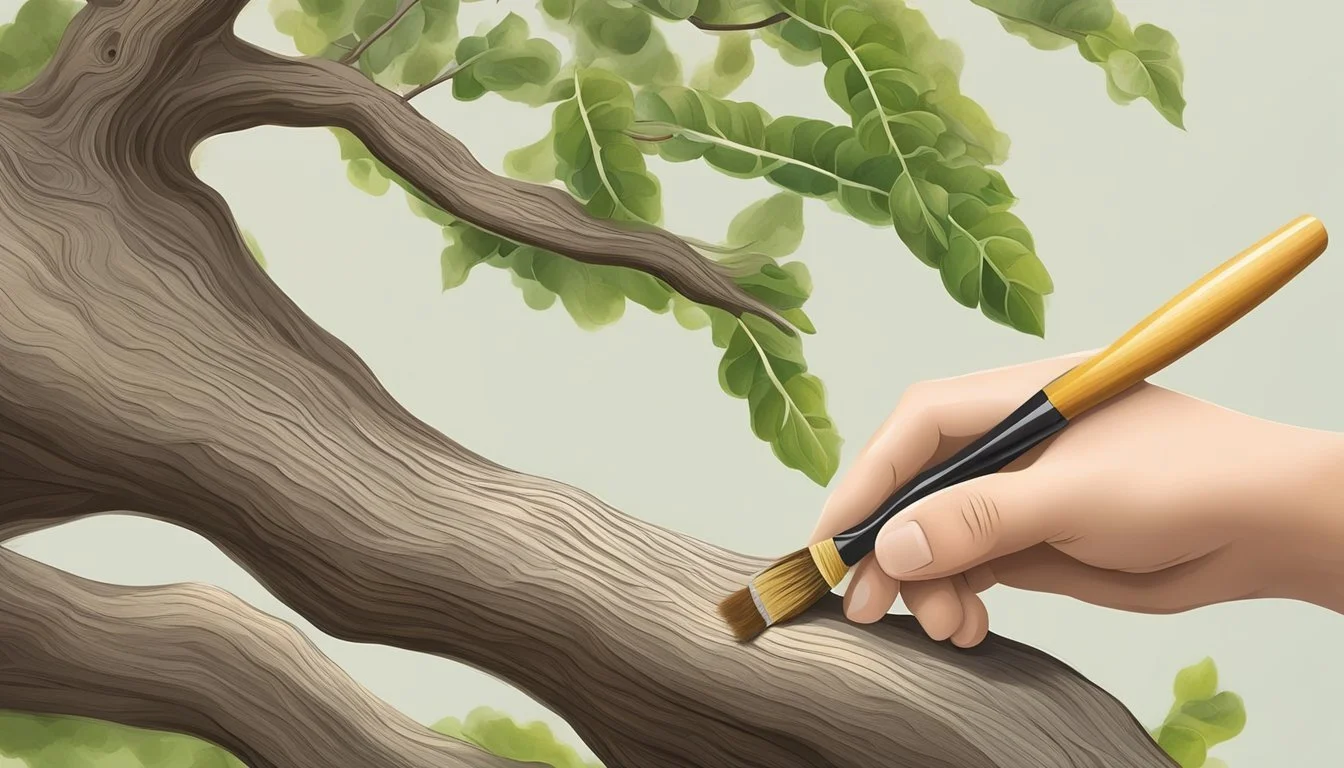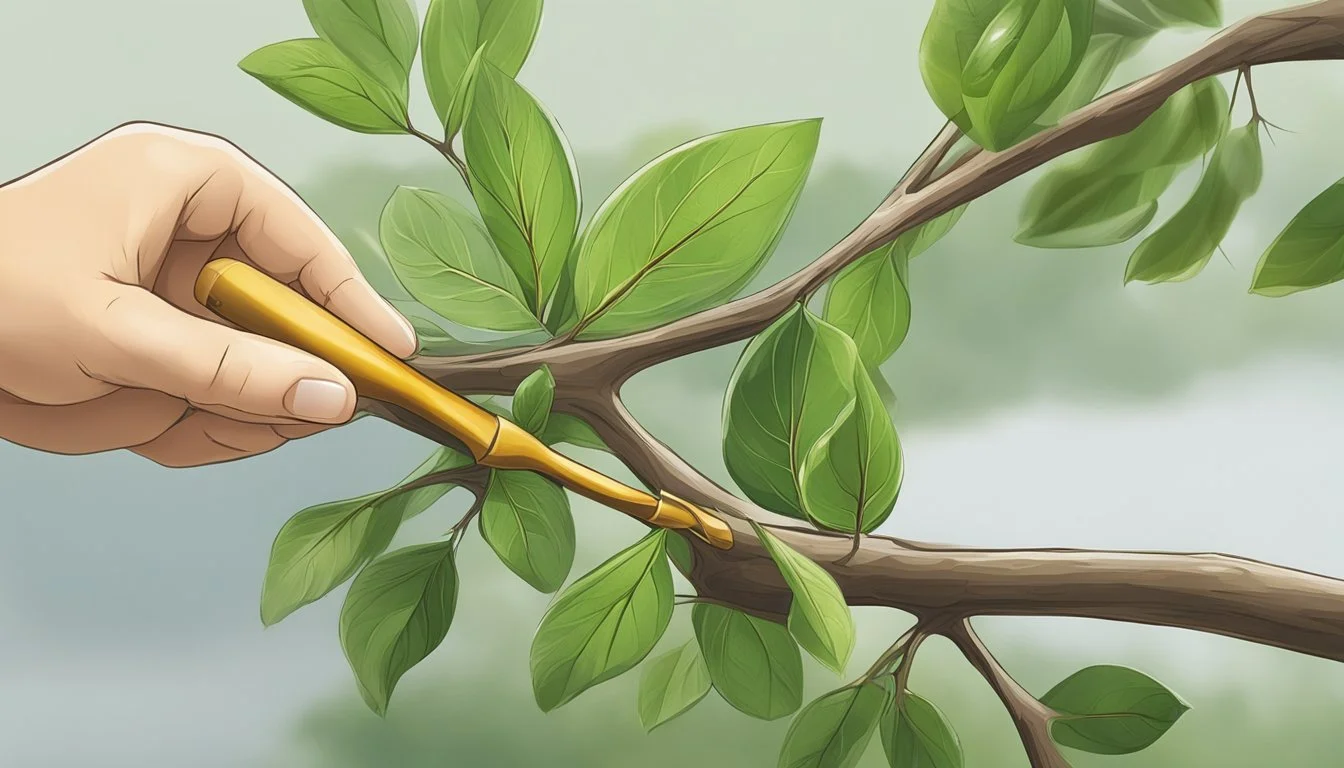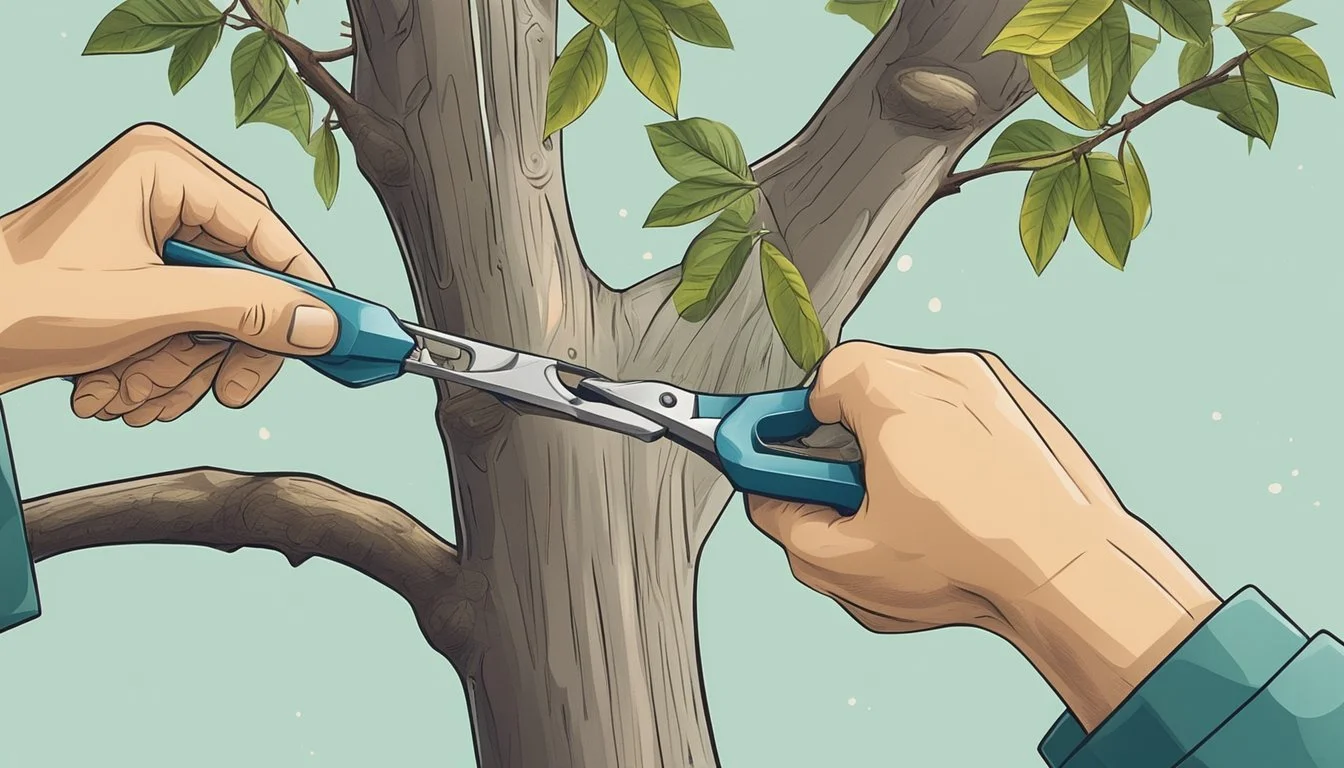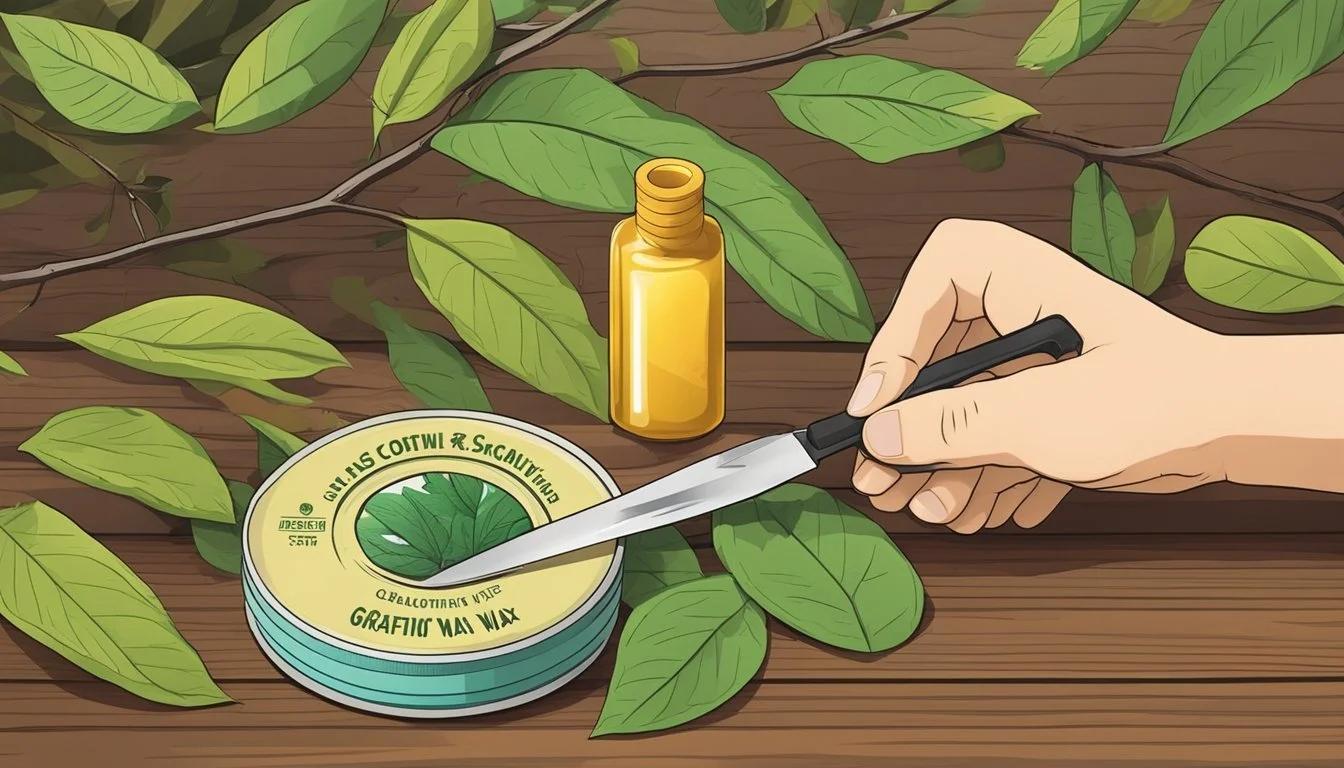The Ultimate Guide to Grafting Wax
Safeguarding Tree Graft Unions with Expert Tips
Grafting is a time-honored technique used in horticulture to propagate plants and trees, ensuring the new growth maintains the desired traits of the parent organism. Grafting wax plays a crucial role in this process by protecting the delicate graft union from environmental stresses such as moisture loss, temperature fluctuations, and potential infections. The selection and application of the right grafting wax can make a significant difference in the success rate of graft take and the overall health of the grafted plant.
The preparation of grafting wax involves a blend of materials that when combined, create a pliable and protective sealant. Traditional recipes often include substances like resin, beeswax, and linseed oil, which are melted and mixed together before being applied to the grafts. The composition of the wax ensures that it adheres well to plant surfaces while remaining flexible enough to accommodate growth. Properly applied, grafting wax not only shields the wound but also maintains the necessary conditions for the vascular tissues of the scion and the rootstock to fuse effectively.
Fundamentals of Grafting
Grafting is a skilled technique of asexual plant propagation that facilitates the union of two plants to continue their growth together. This process ensures genetic consistency and combines desirable traits from both the scion and the rootstock.
Types of Grafting
Various techniques of grafting are utilized, each suited to different plant species and circumstances:
Whip-and-tongue grafting: This method is effective for rootstocks and scions of similar size, involving precise cuts that fit together snugly.
Budding (or bud grafting): It involves inserting a bud into the rootstock, usually performed in the summer when the plant is actively growing.
Cleft grafting: Often used for larger rootstocks, this method includes splitting the rootstock and inserting a wedge-shaped scion.
Side grafting: This is used when the scion is smaller in diameter than the rootstock, with the scion inserted into a side cut on the rootstock.
Understanding Scion and Rootstock
The scion is the section of a plant that is grafted onto another plant, known as the rootstock. The scion typically contains the buds that will form the above-ground portions of the plant. On the other hand, the rootstock is the bottom part that provides the root system and occasionally specific disease resistances or growth characteristics:
Scion: Must be chosen from a healthy, disease-free plant; generally, a young, dormant twig or bud is selected.
Rootstock: Ideally a one to two-year-old plant that is compatible with the scion, contributing to the graft's overall vigor and adaptability.
The Role of Cambium in Grafting
The cambium is a thin layer of generative tissue located between the xylem (wood) and the phloem (inner bark). The success of grafting largely depends on the alignment of the cambial layers of the scion and the rootstock:
Cambial contact: Ensures that nutrients and water can be transported across the graft union.
Grafts must be made with precision to ensure this contact, and secured properly to maintain the position until the union is well-established.
Cambial alignment is critical for the grafted tissues to knit together and form a strong bond, eventually allowing the graft to function as a single plant.
Preparing for Grafting
Preparation is key for successful grafting, which includes the selection of high-quality scion wood, choosing compatible rootstock, and gathering the essential tools necessary for precise cutting and binding.
Selecting Quality Scion Wood
Scion wood should be healthy, disease-free, and harvested from the desired tree variety. It is recommended to use scion wood that is approximately one-quarter to one-half inch in diameter. This scion should ideally be taken from last year's growth during the dormant season, ensuring the highest viability for the graft.
Choosing the Right Rootstock
The rootstock must be compatible with the chosen scion wood and should be about the same diameter for successful union. Young rootstock, one to two years old, is preferred for its vigor and potential for more efficient growth. A clean, diagonal cut approximately 6-8 inches above the soil prepares the site for grafting.
Essential Grafting Tools
For a successful graft, one needs:
Knives: A sharp grafting knife or budding knife is crucial. It should be able to make precise cuts for both the scion and the rootstock. Some grafters may also use a specialized Exacto knife with removable blades.
Pruners: Robust pruners are required for collecting scion wood and preparing the rootstock. A smaller pair is necessary for detailed pruning jobs during the grafting process.
Grafting compound: To seal the graft and prevent disease or drying out, a grafting compound or wax is used. This ensures the cuts are protected while the graft union heals.
Proper sanitation of all tools before use will prevent the transmission of disease between plants, further safeguarding the grafting process.
Grafting Methods
Grafting is a precise horticultural skill designed to combine parts from two or more plants so they grow as one. It involves carefully joining tissues from a plant (the scion) to the tissues of another (the rootstock). The following methods are tailored for different plant species, conditions, or desired outcomes.
Cleft Grafting
Cleft grafting is ideal for changing the varieties of fruit trees in orchards or for top-working additional varieties onto a single rootstock. The process involves making a vertical cut into the rootstock, creating a cleft or wedge shape. A scion with a matching wedge is then inserted into the cleft. This method works well with rootstock of a larger diameter, wherein the scion is much thinner.
Bud Grafting
Also known as chip budding, bud grafting involves taking a bud from a desired plant and grafting it onto a rootstock. It's commonly used in vineyards and orchards for fruit trees such as peaches, particularly the clingstone varieties. Chip budding is performed by making a small, diagonal cut on the stock plant and inserting a similarly shaped piece containing a bud. This method is less invasive and can be done on smaller rootstocks where larger scion wood would not be practical.
Whip and Tongue Grafting
Whip and tongue grafting creates a strong union and is typically employed during the bench grafting process. It is most successful when the scion and rootstock are of similar diameter. A diagonal cut is made on both the scion and rootstock, followed by a second cut creating a 'tongue'. These cuts interlock to provide greater stability and surface area for the graft union.
Bench Grafting
Bench grafting is conducted under controlled conditions, usually in a greenhouse or indoors. The scion wood and rootstock are joined using methods like the whip-and-tongue graft for young trees and shrubs that are not yet planted. Due to its controlled environment, bench grafting allows for the production of grafted plants in bulk before they are moved to their permanent growing location.
Using Grafting Wax
When grafting plants, protecting the graft union is critical. Grafting wax plays a fundamental role in this process, ensuring a flexible seal against environmental threats such as desiccation and infections.
Why Grafting Wax is Essential
Grafting wax is critical for maintaining the viability of the graft union, which is the junction where the scion and rootstock are joined. It serves two main purposes:
Protection from Dehydration: Grafting wax seals the graft union, reducing water loss from the exposed tissues. This is essential because desiccation can rapidly hinder the success of the graft.
Defense Against Pathogens: By creating a barrier, grafting wax lowers the risk of infections at the graft site, which can be entry points for bacteria and fungi.
The use of grafting wax contributes to a more flexible, yet secure union that can withstand environmental stress, allowing for successful grafts.
How to Apply Grafting Wax
Applying grafting wax correctly is vital for achieving the benefits it offers. Here's a step-by-step approach:
Heat the wax: Most grafting waxes need to be melted before application. It should be heated until it is just liquid enough to be workable, but not so hot that it damages plant tissue.
Prepare the graft: Ensure that the graft area is clean and ready for the wax. The cuts should be fresh and align properly for the best union.
Apply the wax: With a brush or spatula, evenly coat the entire graft union with the melted wax. A thin, consistent layer is better than a thick one that might crack as it cools. It is crucial to cover all cut surfaces completely.
Safety is paramount during this process, as hot wax can cause burns. Moreover, an evenly applied, flexible layer of wax can significantly improve the success rate of the graft by creating an optimal healing environment for the grafted plant parts.
Aftercare for Graft Unions
After a grafting procedure, the protection and monitoring of the graft union are crucial to ensure the successful healing and integration of the grafted materials.
Protecting New Grafts
Immediately after grafting, new graft unions are vulnerable and must be protected to ensure the tissues can fuse properly. Using grafting tape or rubber bands is essential for holding the scion in place without causing detrimental pressure. This mechanical support should be firm to prevent movement but must not impede the growth of the callus, a tissue that forms and heals the graft union.
A grafting compound, which can be a specially formulated wax, should be applied over the graft site to seal cuts from pathogens and prevent drying. This barrier aids in the retention of moisture around the graft union, providing conditions conducive to healing.
Monitoring Graft Healing
The healing of the graft union is a gradual process that requires steady observation. Inspecting the union regularly for signs of growth or failure is a key part of aftercare. Within a few weeks, the first indicator of a successful graft is the development of a callus where the scion and rootstock meet. Growers should watch for any signs of:
The scion's growth, which indicates a well-established union
Moisture accumulation under the tape or rubber bands
Signs of decay or infection, which can occur if the graft wasn't sealed properly
They should gradually loosen any string or tape to accommodate the growth of the tree, preventing girdling. If a grafting compound was used, the grower should monitor its integrity, reapplying the sealant if there are any cracks or signs of wear.
Addressing Grafting Challenges
In grafting, the primary concerns revolve around minimizing mistakes, ensuring compatibility, and preventing diseases to achieve successful graft unions, particularly in fruit trees where the stakes are high.
Common Grafting Mistakes
Grafters must pay careful attention to their technique to avoid issues that could lead to failure. One must ensure a precise cut on both the scion and rootstock to facilitate a compatible bond. Poor alignment of the graft can result in a weak union that fails to establish. To mitigate these risks, they should:
Sanitize tools before each use to prevent the introduction of diseases.
Make a straight or diagonal cut on the rootstock and scion for a snug fit.
Ensure that the cambium layers of both scion and rootstock contact each other.
Managing Graft Incompatibility
Incompatibility between scion and rootstock can often lead to graft failure. It usually manifests through poor growth or death of the scion and can be influenced by genetic differences between the grafted parts. A grafter can manage incompatibility by:
Selecting rootstock and scion pairs with known compatibility.
Using interstock—a third piece of plant material compatible with both—between the scion and rootstock.
Observing for signs of weak unions, such as unusual growth patterns or lack of vigor.
Prevention of Grafting Diseases
Diseases can rapidly deteriorate graft unions, especially if the tree's natural disease resistance is compromised. To protect against graft-transmissible diseases, follow these practices:
Use disease-free scion wood and rootstock material.
Apply grafting wax properly to seal the graft and prevent pathogen entry.
Incorporate rootstocks that offer enhanced resistance to certain soil-borne diseases.
By adopting these targeted strategies, the grafter will be better equipped to tackle common challenges and promote healthy, successful grafts in their fruit trees.
Advanced Grafting Techniques
In the realm of grafting, advanced techniques such as dwarfing and interstock grafting play a crucial role in the success of developing specialized trees. These methods involve precise cuts and the selection of specific rootstocks, each tailored for distinct purposes and outcomes.
Dwarfing Techniques
Dwarfing refers to the process of reducing the overall size of a tree through the use of dwarfing rootstocks. Here's how it is done:
Selecting the Rootstock: Choose a dwarfing rootstock known for its propensity to limit the size of the grafted tree.
Compatibility: Make certain the rootstock is compatible with the scion variety to ensure a successful graft union.
Results: The grafted tree should exhibit reduced vigor and a smaller stature, making it ideal for space-constrained environments and easier harvest.
The benefits of using dwarfing rootstock include:
Decreased Space Requirement: Smaller trees occupy less space, allowing for more efficient use of garden or orchard area.
Ease of Maintenance: Dwarf trees are simpler to prune, spray, and harvest due to their reduced height.
Interstock Grafting
Interstock grafting involves inserting an intermediate piece of stem, called "interstock," between the rootstock and the scion.
Steps for Interstock Grafting:
Cutting: Make compatible cuts on both the rootstock and scion, ensuring a snug fit for the interstock.
Interstock Selection: Use an interstock that bridges certain incompatibilities between the rootstock and the scion or imparts desired traits to the grafted tree.
Securing: Fasten the graft meticulously to promote proper healing and integration of the interstock.
Significant aspects of interstock grafting include:
Problem-solving: Addresses compatibility issues between rootstock and scion, enabling the use of a broader range of varieties.
Customization: By choosing specific interstocks, one can influence traits such as growth rate, fruit quality, and disease resistance.
Grafting for Specific Fruit Trees
Different fruit trees have specific needs when it comes to grafting. Each type of tree responds differently to the grafting process, and knowing these distinctions is crucial for successful union and improved fruit production.
Grafting Apple Trees
Apple trees are commonly grafted using the cleft grafting method, especially when dealing with larger rootstocks. A vertical cut is made into the rootstock to form a "V" shape, into which a wedge-shaped scion is inserted. Whip and tongue grafting is another technique frequently used for its strong union, where both scion and rootstock are cut in a way that allows them to interlock. Grafting apple trees is typically performed in late winter or early spring.
Grafting Period: Late winter to early spring
Preferred Methods: Cleft grafting, whip and tongue grafting
Grafting Peach Trees
Peach trees heal rapidly, making them a bit more challenging to graft. The bark grafting technique is often utilized due to the tree's thicker bark, which involves slipping the scion between the bark and the wood. In contrast, chip budding is performed in the summer when the bark peels away easily. For both methods, using grafting wax is critical to protect the exposed tissues and maintain moisture.
Grafting Period: Bark grafting in spring; chip budding in summer
Preferred Methods: Bark grafting, chip budding
Grafting Pear Trees
Pear trees, like apple trees, are often grafted using the cleft grafting method. Due to pear trees' harder wood, ensuring a clean cut and a snug fit of the scion into the rootstock is imperative. Given that pear trees can be susceptible to fungal infections, properly applying grafting wax can serve as a barrier against pathogens.
Grafting Period: Late winter to early spring, before bud break
Preferred Methods: Cleft grafting, sometimes whip and tongue grafting
For all fruit trees mentioned, applying a high-quality grafting wax to seal the graft is essential in preventing desiccation and infection while the graft union heals.
Beyond the Basics
Grafting wax plays a crucial role in protecting graft unions from environmental stresses and pathogens. This section explores how to apply grafting techniques successfully in various climates and the latest advancements in the practice.
Grafting in Different Climates
Temperature and Humidity: Climatic factors significantly influence the healing and success rate of grafts. For instance, in cold climates, grafting wax must provide adequate insulation to prevent the scion from cold damage. Conversely, areas with high humidity may require a wax that's less prone to melting and capable of preventing moisture from causing rot at the graft site.
Dry Climates: It's essential to use a wax that minimizes water loss.
Tropical Climates: In the tropics, the focus shifts to preventing fungal growth with a breathable yet protective wax coating.
Cold: Insulating - Apply thickly
Hot and Dry: Moisture-Retaining - Use sparingly to avoid over-insulation
Humid and Wet: Fungal-Resistant - Ensure coatings are thin and even
Innovations in Grafting
The horticulture and agriculture industries continuously seek more efficient and effective grafting methods. Biodegradable Grafting Waxes: Recent developments include the formulation of eco-friendly waxes that degrade naturally, reducing environmental impact. Smart Grafting Waxes: Some products now come with indicators that change color to signal the appropriate time for additional applications or wax removal.
These innovations not only enhance the survival rates of grafts but also support sustainable practices in agriculture and horticulture.
Propagation Beyond Grafting
While grafting is a popular and precise method for preserving the genetic characteristics of fruit trees, growers have several other techniques at their disposal for plant propagation.
Other Plant Propagation Methods
Cuttings: This straightforward approach involves removing a section of a stem, leaf, or root from a parent plant and allowing it to take root, forming a new plant. For many species, including tomatoes, this method is highly effective and easy to perform.
Layering: In this method, a branch is encouraged to take root while still attached to the parent plant, often by bending it to the ground and covering it with soil. This technique maintains the water and nutrient supply from the parent plant during the rooting process.
Division: Perennials often are propagated by division, where the gardener separates a plant into multiple pieces, each with its own roots and shoots. This method multiplies the number of plants quickly and is particularly useful for herbaceous plants.
Tissue Culture: Also known as micropropagation, tissue culture is a sophisticated method involving growing plants from very small sections of tissue in a sterile, artificial environment. This technique can produce large numbers of plants from a minimal amount of parent material.
Each of these methods can be used to propagate plants, depending on the species and the desired outcome. They offer growers alternatives to grafting plants, providing flexibility in horticultural practices and plant production.
Grafting Tools and Maintenance
When it comes to grafting trees, having the right tools is essential for the success of graft unions. Among these tools, knives play a pivotal role. There are specific grafting knives designed for this purpose, as well as budding knives with blades approximating three to four inches in length. A sharp knife is imperative for clean cuts that increase the chances of successful grafting.
Maintenance of Grafting Knives:
Regular Sharpening: Keep the blades razor-sharp for precise cuts.
Cleaning: After each use, clean to prevent disease transmission.
Proper Storage: Store in a dry place to avoid rusting.
Protective Gear: A pair of sturdy leather gloves can protect the gardener’s hands not only from cuts but also from potential infections. It is crucial that the gloves used are both flexible for dexterity and robust for safety.
Table of Essential Grafting Tools:
Grafting Knives: Used for making precise cuts on scions - Sharpen periodically; clean regularly.
Budding Knives: Specially designed for budding - Keep blade sharp; store safely.
Leather Gloves: Protects hands during the process - Clean after use; inspect for wear.
Sharp Knife: May substitute for a grafting knife - Follow same care as grafting knives
In maintaining these tools, one must ensure they remain sharp and clean. This not only aids in the grafting process itself but also helps with the upkeep of the tools, making them last longer and perform better. Clear cuts and safe practices play a significant part in the overall success of grafting efforts.
The Science of Grafting
Grafting is a horticultural technique where a gardener fuses two plants together to form a single, functional organism. At its core, the process involves connecting the cambium layers of a scion—the cutting that provides the top of the graft—with those of the rootstock, which is the bottom part that remains rooted in the soil. The cambium is a thin layer between the wood and the bark where new growth occurs, and it plays a vital role in the success of a graft.
A successful union requires the alignment of the cambium layers of both the scion and rootstock, allowing for the integration of their vascular systems. The phloem cells, which are part of this system, facilitate the flow of nutrients and sap—the plant's lifeblood—between the two parts. For the graft to take hold and thrive, the scion must be secured to the rootstock with grafting wax or tape, creating an environment that retains moisture and prevents disease.
Key Steps in Grafting:
Cut scion and rootstock to expose fresh cambium
Align scion and rootstock cambium layers
Secure graft union with grafting wax
Monitor for growth and healing
Influence of Environmental Factors:
Ethylene: A natural plant hormone that can affect healing and growth of grafts.
Soil: Provides nutrients to the rootstock which supports the new graft.
Proper care post-grafting ensures that the newly formed union is protected from environmental stress, disease, and pests, allowing both the scion and rootstock to grow as one cohesive tree—which, if done correctly, will bear fruit in accordance with the characteristics of the scion's origin.
Seasonal Grafting
Seasonal factors significantly influence the success rate of grafting trees. Specifically, the dormant period, which typically occurs during winter, is an optimal time for grafting. Trees are in a state of rest, and sap flow is minimal, reducing the risk of infection and ensuring better adhesion between the graft and the rootstock.
Optimal Timing
Dormant Period: Trees should be grafted in late winter or very early spring before they break dormancy.
Sap Flow: Minimal sap flow during dormancy allows for cleaner grafting cuts and improved union formation.
Tips for Winter Grafting
Storage of Scion Wood: Harvest scion wood during dormancy and store it in a cool, moist environment until grafting time.
Protection: Use grafting wax immediately after grafting to seal cuts and prevent desiccation or disease entry.
Temperature Considerations
Avoid Frost: Ensure grafting is done after the last hard frost to prevent damage to the delicate graft tissue.
Healing Environment: Temperatures should eventually rise to facilitate the healing and growth of the graft union.
By adhering to the dormant season for grafting, gardeners and arborists take advantage of the tree's natural cycle, promoting successful grafting outcomes. The application of grafting wax during this time is critical to protect the new union from environmental stressors and pathogens, ultimately ensuring the vigor and productivity of the grafted tree.
Specialized Grafting Environments
In specialized grafting settings such as nurseries, orchards, and vineyards, maintaining a consistent environment is critical for successful grafting. These environments often rely on controlled conditions to safeguard the delicate graft union against external stressors.
Nurseries typically foster a highly managed environment for young trees. Humidity and temperature are regulated to ensure that grafts heal properly. The use of grafting wax in nurseries is a meticulous process, where the composition may vary depending on the type of plants and the conditions under which they are grown.
For orchards, the focus is on large-scale production. Grafting wax plays an essential role in protecting the grafts from weather elements and pests. Orchard managers must choose wax that is easy to apply yet durable enough to withstand the specific demands of an outdoor environment.
Vineyards present unique challenges due to the nature of grapevines. Here, grafting wax must accommodate the vining growth pattern and resist cracking from the plant's movement and growth. In vineyards, grafting wax not only facilitates the healing of the graft union but also ensures a secure bond as the vines stretch and climb.
Nurseries: Purpose of Grafting Wax - Enhance healing in controlled conditions; Considerations - Adjusts to temperature and humidity
Orchards: Purpose of Grafting Wax - Protect grafts in large-scale production; Considerations - Durability against weather and pests
Vineyards: Purpose of Grafting Wax - Support vine growth and flexibility; Considerations - Resistance to movement and growth
Each environment demands a specific approach to grafting wax application, providing the best possible conditions for graft success.
Long-Term Care and Production
After successful grafting, long-term care of the graft union is crucial for the production of a healthy, fruitful tree. The following are key steps to ensure the graft unions are safeguarded and the fruit trees have the best chance of thriving:
Monitoring the Graft Union: Regularly inspect the graft union for signs of disease or weakness. A strong union will have no gaps and should show signs of cambial connection as the healing process continues.
Supporting the Graft: Sometimes, stems or the graft union may need support to prevent breakage due to wind or the weight of the production. Stake and tie them if necessary, being careful not to damage the union.
Pruning: Careful pruning is essential to direct the tree's resources toward the development of the grafted section. Remove any suckers or growth below the graft union that could divert energy away from the desired scion.
Protection: Guard the graft union against pests and harsh environmental conditions. Apply tree guards or wrap if there is a risk of rodent damage or sunscald.
Fertilization and Watering: Balanced fertilization and regular watering are important for the overall health of fruit trees and the success of the graft. The right nutrients support growth and production, while consistent watering ensures the graft does not dry out.
Following these practices, fruit trees are more likely to produce abundantly. The health and productivity of the graft union are directly tied to the care provided during its critical development phases.
Grafting Safety and Best Practices
When engaging in the process of grafting trees, ensuring safety and adhering to best practices is crucial. A sharp grafting knife is vital for making precise cuts, reducing the risk of injury and increasing the chances of a successful union. Users should always cut away from their body and keep the blade sharp to minimize slippage.
Equally important is the use of a grafting strip to secure the graft. This helps maintain contact between the scion and rootstock until the graft has taken. Strips should be flexible and durable, providing support without damaging plant tissue.
After completing the graft, practitioners often apply a layer of wax to seal the union. Sawdust, ideally moist and aged, can be used to store newly grafted trees. The sawdust helps maintain a cool, moist environment, which is conducive to the healing of the graft.
When larger cuts are needed, a saw might be employed, followed with a chisel to refine the angles for more complex grafts, such as a cleft graft. All tools must be treated with care, kept clean, and regularly disinfected to prevent the spread of disease between plants.
Lastly, it’s advisable to conduct grafting with a partner. They can help in holding branches steady, providing tools, or calling for assistance in case of an accident. By following these safety protocols and best practices, grafters can ensure both their safety and the health of the trees.
Storing Grafting Materials
When handling grafting materials, proper storage is crucial for maintaining their viability and effectiveness. Grafting compound, a blend commonly composed of resin, beeswax, and other elements, is an essential component for protecting graft unions. For optimal preservation, these materials should be kept in a cool, dry environment.
Grafting Compound: It should be stored in its original container with a secure lid. This helps prevent contamination and ensures the compound remains at a consistent quality. If the compound has been mixed or melted for application, any leftovers can be cooled and re-solidified for future use. In between grafting seasons, storing the grafting compound in a refrigerator can extend its shelf life, although this is not always necessary provided the storage temperature is stable.
Containers and Tools:
Knives and Pruners: Clean tools after each use to reduce the risk of disease. Dry them thoroughly to prevent rust.
Wax and Resin: These materials should not be exposed to high temperatures. Store in a cool place away from direct sunlight.
Grafting Compound: Recommended Storage Conditions - Cool, dry place; if possible, refrigerate
Tools (Knives, Pruners): Recommended Storage Conditions - Clean, dry location; oil to prevent rust
Moisture and Pests: Keep containers sealed to prevent moisture buildup, which can lead to mold or degradation. Furthermore, an airtight container will protect materials from insects and rodents that might be attracted to organic components like beeswax.
By storing grafting materials correctly, they assert their longevity and performance, thereby supporting successful grafts on trees.















